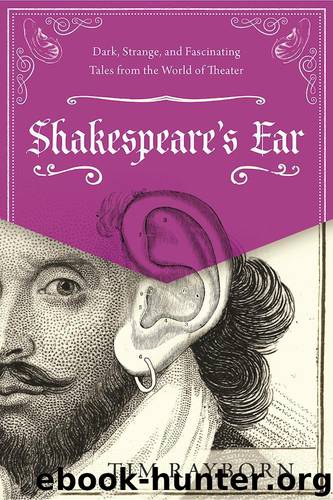Shakespeare's Ear by Tim Rayborn

Author:Tim Rayborn
Language: eng
Format: epub
Publisher: Skyhorse Publishing
Published: 2017-04-10T04:00:00+00:00
The Old Price riots (1809)
Sometimes bad things happen for mundane reasons. When the Theatre Royal at Covent Garden burned down on September 20, 1808, it was a great tragedy, as the props, costumes, and play scripts were lost, along with original music by composers such as George Frideric Handel and Thomas Arne. Worse, at least twenty-two people were killed when the roof crashed down on them. The total damage was estimated at about £250,000, an absolutely enormous sum for the time. The fire was believed to be accidental, probably caused by some smoldering fabric set off by a spark from a theatrical gun that was not properly extinguished after a performance.
Work on a new theater began soon after, and it was completed and set to reopen almost exactly one year later, on September 18, 1809. There was a problem, though. The costs for building the replacement were so high that management was forced to raise prices, an age-old problem that brings age-old protests. Price hikes were introduced across the board, and some seats that had previously been open to the public were converted into private boxes for rent at expensive annual sums, which exposed some of the class divides that were already causing dissention in other areas of London life.
This gentrification of their entertainment did not sit well with the public, and on opening night, they were at the venue and mad as hell. While the manager, John Philip Kemble, attempted to give a rousing speech from the stage about the restoration of the theater, filled with patriotic pride, the crowd grew increasingly restless. The Times reported: “We believe not a single word … was heard by the most acute listener in the house: hisses, groans, yells, screeches, barks, coughs, shouts, cries of ‘Off! lower the prices! six shillings! pickpockets! imposition! Cut-purse!’” It may or may not be significant that the intended play for opening night was Macbeth, which has a long history of bad luck attached to it (see the chapter on superstitions in act II). Was this mishap yet another example of “the Scottish Play” causing disruption?
In any case, thus began the Old Price riots, which, despite their name, didn’t do all that much rioting and caused little damage or injury. They were intended as a form of loud civil disobedience to force the manager to revert to the, well, old prices. Kemble mishandled some things in trying to deal with the disorder, such as when he hired professional boxers Daniel Mendoza and Samuel Elias to act as bouncers for some of the louder and more unruly patrons. This, as you can imagine, didn’t go over well, and the disruptions escalated. These riots would carry on for the next two months, and Kemble was ultimately forced to apologize and lower prices back to what they had been previously—score one for the people! In the future, theaters were more careful about how they raised prices in view of this boisterous revolt, being fearful of another uprising.
Download
This site does not store any files on its server. We only index and link to content provided by other sites. Please contact the content providers to delete copyright contents if any and email us, we'll remove relevant links or contents immediately.
Periodization Training for Sports by Tudor Bompa(8171)
The Body: A Guide for Occupants by Bill Bryson(4975)
The MacArthur Bible Commentary by John MacArthur(4749)
The Sports Rules Book by Human Kinetics(4296)
What It Really Takes to Get Into Ivy League and Other Highly Selective Colleges by Hughes Chuck(3697)
Marijuana Grower's Handbook by Ed Rosenthal(3623)
The Sprouting Book by Ann Wigmore(3543)
The Martian by Andy Weir(3310)
Salt, Fat, Acid, Heat: Mastering the Elements of Good Cooking by Nosrat Samin(3108)
The Bread Bible by Rose Levy Beranbaum(3004)
Harry Potter 4 - Harry Potter and The Goblet of Fire by J.K.Rowling(2990)
Sapiens and Homo Deus by Yuval Noah Harari(2987)
The Marketing Plan Handbook: Develop Big-Picture Marketing Plans for Pennies on the Dollar by Robert W. Bly(2977)
Classic by Mary Berry(2942)
Martha Stewart's Baking Handbook by Martha Stewart(2796)
Screenplay: The Foundations of Screenwriting by Syd Field(2576)
The Plant Paradox by Dr. Steven R. Gundry M.D(2548)
50 Economics Classics by Tom Butler-Bowdon(2524)
The Cambridge Grammar Of The English Language by Rodney Huddleston Geoffrey K. Pullum(2385)
